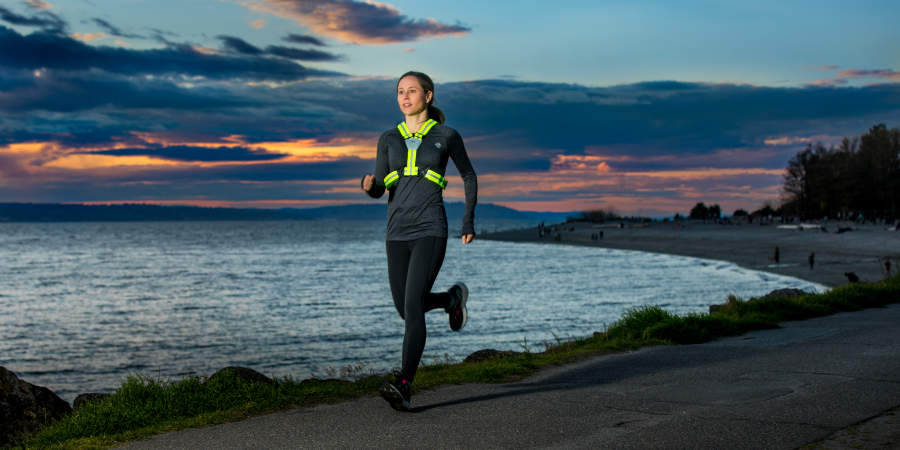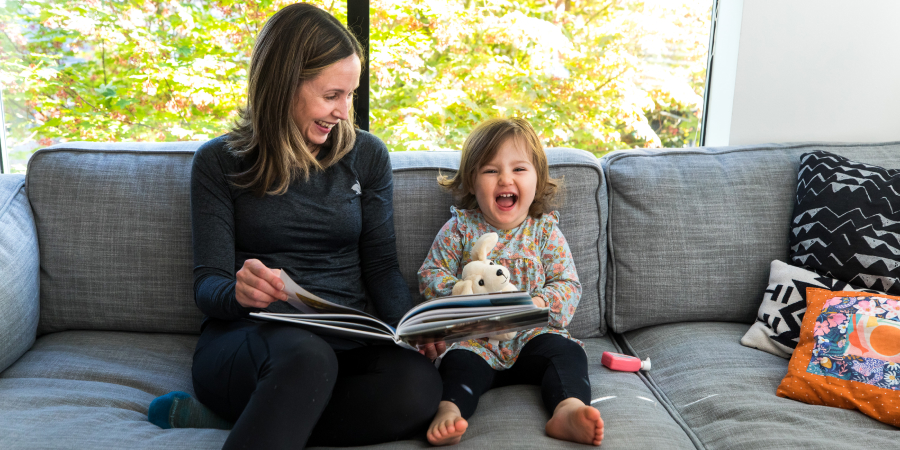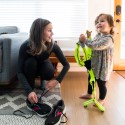The sun starts to warm the pavement as I finish my last lap through the neighborhood. I’ve been running for nearly an hour and, though my legs are tired, I could keep going for a little longer. Instead, I go inside and pull off my glowing vest—the closest thing I have to a running buddy on early mornings like this. I don’t notice the vest when I’m running, but I’m aware of its effect—the way it helps me stand out to cars and signals my presence to other runners who are also out there, moving through the ink-black darkness before sunrise. I untie my shoes and pop out my ear buds. Blurry data points float up at me from my GPS watch, but I barely register them. I don’t need to. It’s been a good run.
Most of my runs don’t go like this.
In my late 20s and early 30s, I was the kind of runner who set my alarm early, shoving an energy bar in my mouth and lacing my shoes long before the sun came up. I flew along the sidewalks in my Seattle neighborhood with a headlamp strapped to my forehead, training for this 10K or that trail race. I wasn’t particularly competitive or obsessive, but I was a runner.
Everything changed in 2020. I was nine months pregnant when the U.S. confirmed its first Covid-19 death. In April, as hospitalizations ticked upward, my husband and I disappeared into our local childbirth center. When we emerged with our daughter Nora three days later, the cherry trees around the hospital campus burst into blossoms the color of cotton candy. We wept. We’d been prepared to welcome a new human. We hadn’t expected to also be new humans, completely transformed and at a loss about the world around us.
Six weeks after Nora’s arrival and with the OK from my doctor, I embarked on my first run back. I found an opening one afternoon between nap times and wakings and bottle feedings, slid into my running shoes and went. In my eagerness to get back out there, it didn’t cross my mind to warm up or ease into it.
Big, fat raindrops and neon-green lawns blurred by as I raced around the 2.8-mile paved loop across the highway from our house. I exchanged tentative, knowing glances with fellow runners trudging through the Seattle summer rain. For a blissful 30 minutes, running consumed me. It felt great.
When I stumbled back home—a tangle of mud, sweat and endorphins—I realized I was sore, and not in the good “I exercised!” way. I spent the next hour trying to keep weight off my feet. Although I slowly began to up my mileage in the months that followed, my progress was anything but linear. One day, I ended a tempo run convinced I’d pulled a hamstring. The underlying culprit was diastasis recti, a condition that affects many pregnant women, in which your ab muscles separate to make space for the growing baby. Cue weeks of postpartum physical therapy and targeted ab exercises.

Motherhood is full of clichés. “Nothing prepares you for what it’s like to have a baby,” people say. “Your heart grows ten sizes.” I used to roll my eyes at those platitudes. Now, I get it. “It’s profound,” I manage, when someone asks about what it’s like to become a mom. “It’s the single-greatest thing …”
I still haven’t figured out how to fully describe the transition to parenthood. What I know is that my edges are softer. I’m a little more patient, a little less incisive. My body is softer, too. I rarely had the energy to go for a run or strength train when Nora was a newborn. I’d pick up a set of 5-pound weights and my legs would turn to jelly (likely caused by relaxin, a ligament-loosening hormone that prepares the body for childbirth and remains in the system while breastfeeding).
In my previous life, I’d spend weekend mornings getting lost in our local urban parks. But after Nora was born, I’d catch myself veering toward home at the thought of her infectious giggles. My relationship to running, like everything else, changed. That doesn’t mean I love it any less.
I moved running to the margins of the day when I went back to work in October 2020. I ran early. I ran late. I always left feeling a bit frantic and came back feeling better. At least some things hadn’t changed. Until one night that fall when I slipped through the front door to find my husband scowling up at me from the floor with our then-6-month-old.
“Where’s your light?” He asked. I glanced down at my headlamp, which I’d wrapped around my wrist when it died halfway through my run. “You’re out there in all black without a light?”
He’d chided me before for running without enough reflective gear. But now things were different. For the last six months, we’d sidestepped every identifiable risk. We’d washed hands, worn masks, swapped hugs for waves. I’d bleached sheets, sterilized bottles and woke, palms sweaty, to every cough from our daughter’s crib. We’d read the news. Scrolled through Twitter. Stared at each other in disbelief.
Despite all that, things had started to get better. A vaccine was coming, and would be widely available by spring 2021. Our parents had visited, traveling cross-country with face shields and vats of hand sanitizer so that they could safely hold our tiny babe. We’d breathed a half-sigh of relief. But things were still tenuous. My husband’s look said, We’re not in the clear enough to be careless about anything. He was right. Hospitalization, for any injury or ailment, was now a different ordeal under COVID.

The next morning, I found a bright yellow Amphipod Xinglet reflective running vest draped across my running shoes near the front door. I didn’t ask my husband about it, I just wept. Some people say the best gift is the one you’d never buy for yourself. Others say it’s the one that’s spot on—made for you.
About the Xinglet, both were true. I’d had the Xinglet in my REI shopping cart for months, but I’d been dragging my feet. My husband knew that. And he knew running was my thing, had always been my thing, even if it felt different now—a little less like dancing across pavement and a little more like escaping, for a few brief moments, the privilege and weight of having a baby amid a pandemic.
Now I reach for my Xinglet most days. I fold it optimistically across my running shoes on nights when I manage to get Nora to bed before 9pm, willing my future self out of bed and out the door into the early Seattle mist the next morning. More often than not, I slide into the Xinglet in the frantic moments when my husband and I finish up work for the evening. I usually barely make it out the door. When I do, the hour I spend shuffling along the pavement is the best part of my day.
Though the vest, with its fluorescent hue and reflective stripes, helps make me more visible to cars, I don’t run longer, faster or more boldly in the Xinglet. In fact, my pace is slower than at any point in my adult life. I’m less consistent, my gait a little less graceful. I’m still doing postpartum physical therapy. But I’m out there. The cars are finding their way home and the light is dying and, for a few blissful moments, it’s all OK.

